

Doctors warn that antibiotic-resistant strain of gonorrhea could be 'worse than AIDS' Gonorrhea is the second most commonly reported sexually transmitted disease in the U.S.A growing number of cases are being reported globally of an antibiotic-resistant strain known as HO41It has been listed as a superbug and doctor are warning it has the potential to become very dangerous very quicklyGonorrhea is especially common amongst young people aged 15-24 By Daily Mail Reporter Published: 13:49 GMT, 1 May 2013 | Updated: 13:49 GMT, 1 May 2013 Doctors are warning that an antibiotic-resistant strain of gonorrhoea, now considered a superbug, has the potential to be as deadly as the AIDS virus.

Gonorrhea is the second most commonly reported sexually transmitted infection in North America. This particular strain of gonorrhea, known as HO41, was discovered in Japan two years ago in a 31-year-old female sex worker who had been screened in 2009. What Is An Antibiotic? When you take an antibiotic, it enters your bloodstream and travels through your body, killing bacteria but not human cells.
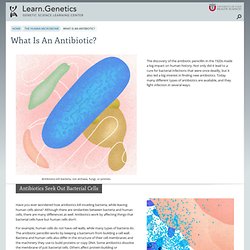
There are few differences, however, between harmful and friendly bacteria. Antibiotics kill not only the bad bacteria making you sick, but also your resident friendly bacteria. Friendly bacteria help keep you healthy in many ways, so when antibiotics kill friendly bacteria, your health can suffer because you lose these benefits. Additionally, losing friendly bacteria can give other types of bacteria room to multiply, leading to opportunistic infection. Sometimes opportunistic infection happens when bacteria from the environment get into your body and overrun friendly bacteria damaged by an antibiotic. Antibiotic Resistance. Intrinsic Resistance In some cases, a type of bacteria will survive antibiotic treatment and multiply because it is intrinsically resistant.
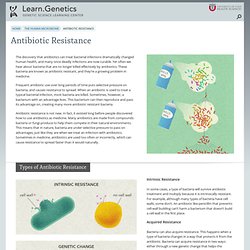
For example, although many types of bacteria have cell walls, some don’t. An antibiotic like penicillin that prevents cell-wall building can’t harm a bacterium that doesn’t build a cell wall in the first place. Acquired Resistance Bacteria can also acquire resistance. Genetic Change So how can a simple DNA change protect bacteria from antibiotics? Changes like this can prevent an antibiotic from getting into the cell, or prevent the antibiotic from working once it’s inside. DNA Transfer. Antibiotic Resistance. Eedwood House Farm is easy to miss.

Only a small sign - the bright pink image of a pig - suspended from a fence post hints at anything of significance down the one-way track that leads off the main road. After a few hundred metres of bouncing over mud and gravel, it is the pungent smell that smacks you first. Then, the sound; the squealing, grunting and growls of 5,000 pigs crammed into this corner of rural Staffordshire. A hundred or so piglets are excitedly clambering over each other or snuffling around the muddy floor of the gated outdoor enclosure where they are waiting to be transported for slaughter.
Inside the great barns, 500 sows lie side-by-side in pens while their offspring fight for space at their teats.The air hangs heavy with ammonia, so thick it stings the lungs. This is the flagship operation of Midland Pig Producers, which runs nine farms across the country producing 80 tonnes of meat a week to supply Tesco, Marks and Spencer and Asda. Infographic National Risk Register. Is this antibiotic apocalypse? Antibiotic-resistant superbug arose in northern Manhattan.
Human skin is a garden of microbes that is home to about 1,000 bacterial species.
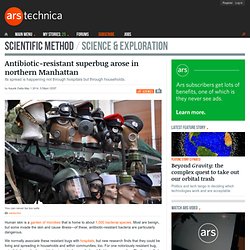
Most are benign, but some invade the skin and cause illness—of these, antibiotic-resistant bacteria are particularly dangerous. We normally associate these resistant bugs with hospitals, but new research finds that they could be living and spreading in households and within communities, too. For one notoriously resistant bug, scientists have also been able to pinpoint where and when it first began spreading. The hope is that this knowledge will allow a better way of controlling infection and stopping epidemics. About one in five humans carries the disease-causing bacteria Staphylococcus aureus, or Staph, on their skin without any problem. The spread of methicillin-resistant Staphylococcus aureus (MRSA) is well known.
CA-MRSA spreads by contact with an infected individual. Global epidemic While the presence of Staph on skin has always put people at risk for infection, two features make CA-MRSA riskier. World Health Organization warns of “post-antibiotic” era. I grew up with a constant reminder of the pre-antibiotic world.
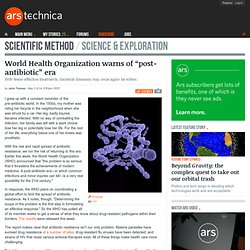
In the 1930s, my mother was riding her bicycle in the neighborhood when she was struck by a car. The other downside of antibiotics: Killing the useful bacteria. Everyone has a pet theory to explain the rise of modern scourges, things that our forbears rarely had to contend with during their short, brutish lives: obesity, diabetes, celiac disease, autism, asthma, allergies, esophageal cancer, etc.

Plastics, pesticides, and genetically modified crops are perennial favorites; wheat seems to be the darling of the moment. Martin Blaser, the director of the Human Microbiome Program at NYU, thinks that these ills are due to the overuse of antibiotics. He uses his new book, Missing Microbes: How the Overuse of Antibiotics Is Fueling Our Modern Plagues, to argue that the broad spectrum of antibiotics that is relied upon by modern medicine disrupt the microbiome, the diverse bacterial ecosystem that has been residing in human bodies ever since there were human bodies.
The idea holds up scientifically too, as Blaser demonstrates. One of the most interesting insights that the book delivers concerns antibiotics' relationship to obesity. Antibiotics: How taking them can make you fat, ill and prone to auto-immune diseases. By Jerome Burne Published: 23:39 GMT, 6 August 2012 | Updated: 00:31 GMT, 7 August 2012 By wiping out our gut bacteria, antibiotics could be making us fat At first glance it sounds like an ad for a dodgy herbal supplement.
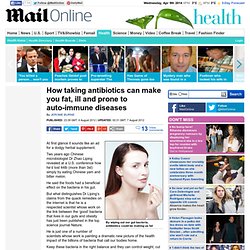
Two years ago Chinese microbiologist Dr Zhao Liping revealed at a U.S. conference how he’d lost 44lb (more than 3st) simply by eating Chinese yam and bitter melon. He said the foods had a beneficial effect on the bacteria in his gut. But what distinguishes Dr Liping’s claims from the quack remedies on the internet is that he is a respected scientist whose work on the link between the ‘good’ bacteria that lives in our guts and obesity has just been published in the top science journal Nature. He is just one of a number of scientists whose work is painting a dramatic new picture of the health impact of the billions of bacteria that call our bodies home. It may even be possible to use beneficial bacteria to switch certain genes on or off.
No one really knows how it works yet.